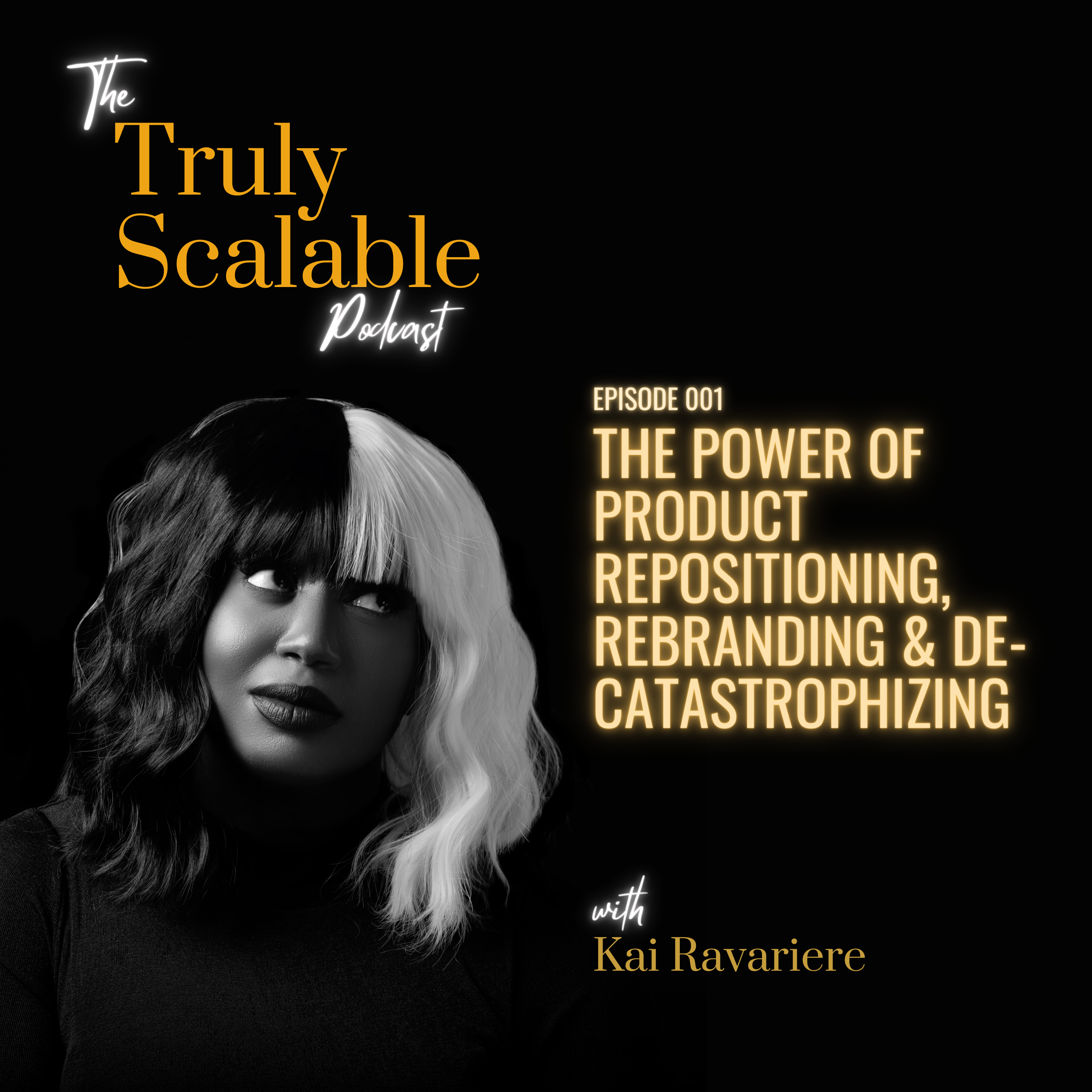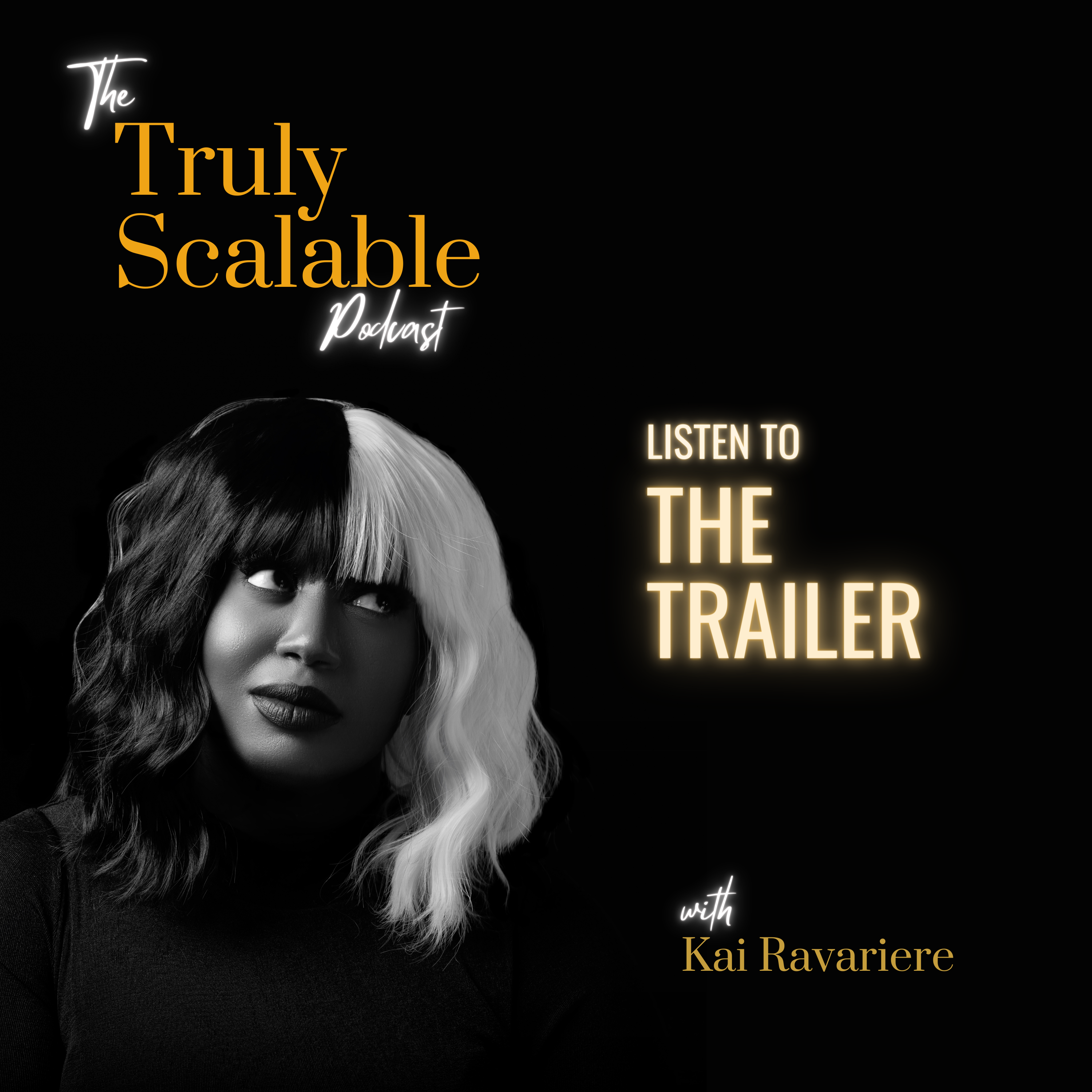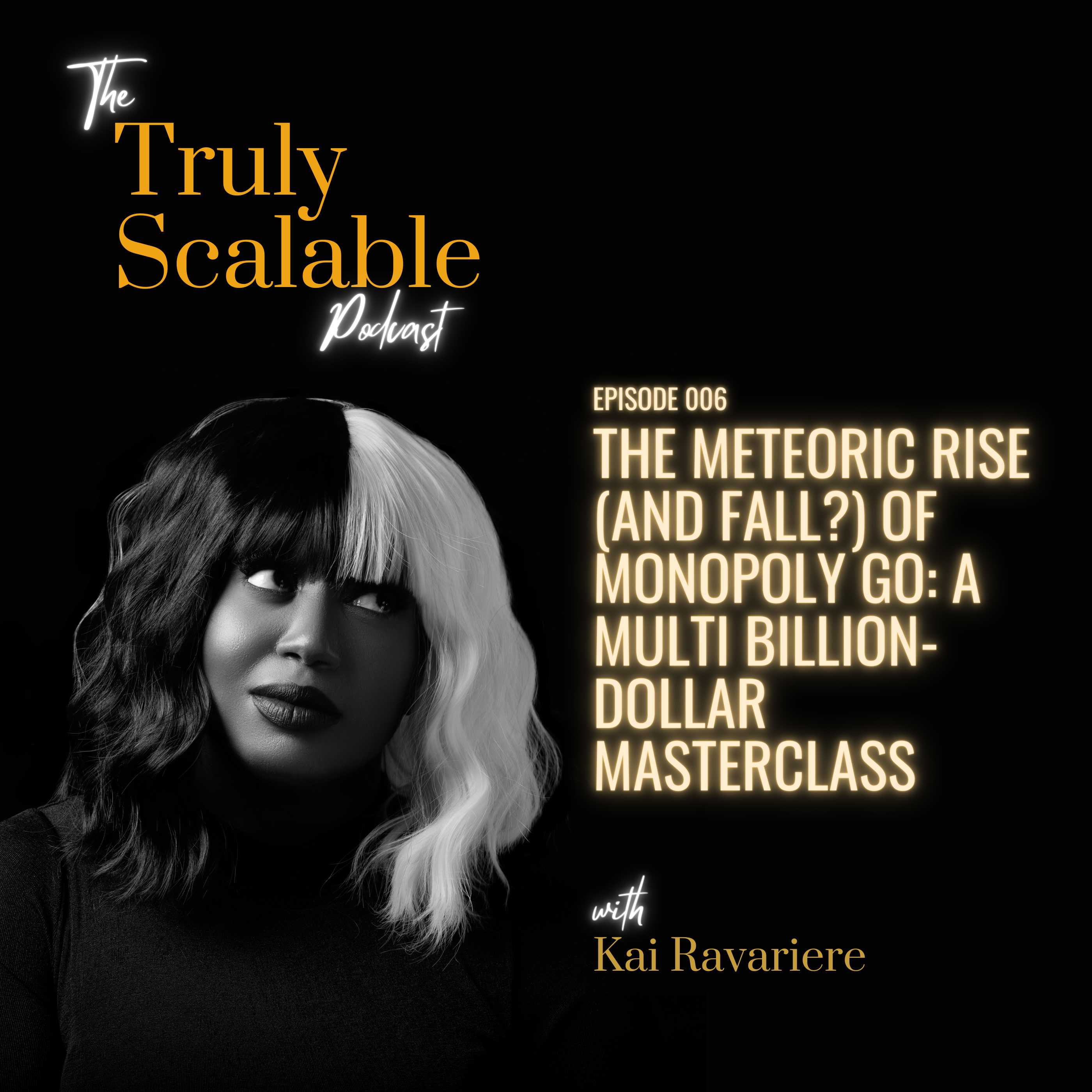[00:00:05] From the KR agency. It's the truly scalable podcast, a show for direct to consumer e commerce brands focused on optimizing and strengthening the backbones of their brands, companies and teams to ensure fast, highly profitable scaling, growth and success. However you define it, marketing, advertising operations, fulfillment, leadership, data scaling architecture join me as we demystify the master keys for e commerce brand founders and cmos to strengthen the makeup of their businesses and layer smart strategies for maximum profitability at scale. I'm Kaira Varier and I'm here to help you become truly scalable.
[00:01:00] Welcome everyone, to the very first pilot episode of Truly Scalable. For this show, I wanted to do something a little different than the norm. When I first began my journey nearly a decade ago, buying media and scaling companies, I fervently wished I could find a space where someone would not only help me cut through all the noise and the bull that exists in the Internet marketing industry, but who would also give me the unadulterated, unfiltered version. Who would let me pass the gates of their mind so I could vicariously discover life lessons, failures, observations, frustrations and losses in entrepreneurship too, not just their wins and case studies. Had someone been open enough and secure enough to have put this out there at that time, I probably would have gotten a 1.5 billion in revenue for our clients a heck of a lot faster. And I would have completely changed the trajectory of my success as a growth strategist in CMO on truly scalable, I'm giving you the gift I never got. Rooted in 168,000,000 in ads, data to date from the hearts and minds of myself and my world class team of scaling architects, wordsmiths, growth strategists, creatives and consultants across every facet of ecommerce you can think of. That means that here you're going to get insights into what's gone right lately, what's gone wrong, brands that are killing it, brands that aren't what we've observed in the world of Ecom and lessons I'm learning as a growth architect, entrepreneur, media buyer and human being on my own journey to $10 billion in impact. I'm Kaira Varier, and for those who don't know me, I'm the founder and principal at the Kra agency, lovingly known as KrA. Now, if I'm going to keep it a buck, it really shouldn't matter. And in future episodes, I'll get into why that is. But apparently it does. So let me give you a quick rundown of my background and what I've been up to. Before my career in digital advertising and growth, I was a Fortune 20 fiver in corporate strategy and leader in investment banking, worked on an award winning team at the top ranked investment bank in the world. Sounds sexy and cool, I know, but don't get it twisted geek runs in my veins. Before that, I was an astrophysics researcher at one of the most lauded astrophysics undergrad programs in the country. Many of my contributions have been academically published. Over the past eight years, though, I have become obsessed with all things growth and scaling for companies all over the world, from startups to enterprise brands and everybody in between. I'm a leader of a global community of ecommerce entrepreneurs with members in 23 countries who are avid readers of my weekly newsletter the Growth geek. I'm a columnist for Forbes and Ink magazine, where I wax poetic on all things ecom and digital and have also been featured in pieces in partnership with Shopify. I'm a growth strategist and fractional cmo for direct to consumer ecommerce brands that are looking to scale to seven, eight, nine figures. The difference between me and most is that I also have a digital advertising agency at my back who helps brands execute all the juicy bits and recommendations I give them on growth, scaling, profitability and becoming truly scalable. And in case you're wondering what that actually means, truly scalable brands are brands that are able to grow and scale in any climate, no matter the channel volatility that exists due to platform shenanigans, no matter the economic uncertainty that exists across the landscape, and no matter what's going on amongst audiences in the market, because they've designed and built out a scaling architecture in a very intentional way across channels and departments that insulates their brand from the bulk. We'll get into that a ton more on many episodes of the show. But the highly structured, highly process driven philosophy and approach we've developed is how I and my teams have generated 1.6 billion in revenue for ecommerce brands at three times the average roas and at an average 38% net overall profitability across industries. Now to start off, let's get into what went right this week.
[00:04:52] I'll start off with this. I have a nasty habit of catastrophizing. In other words, I tend to take hypotheticals to an extreme that assumes the outcome will be way worse than could ever be realistic, which makes it really easy for me to assume the worst outcome. The benefit to this is that I'm often more than prepared for worst case scenarios or unexpected turns, but it honestly does more harm than good. Where in the past it's built up a level of fear that stopped me from taking on projects or doing things that could have really furthered my own personal progress and professional goals. So over the years, I decided to wean myself off of this practice, or in the very least, make a pointed decision to move and progress forward in spite of the catastrophic outcomes ping ponging around in my head. So for the first time in the course of my career in advertising, I recently took time off in Q four, one of our busiest quarters of the year in the ecommerce agency and growth world. Even though every bone in my body was screaming about all of the ways this could potentially go wrong. Now, I'd been incredibly nervous about this, but the burnout off of the back of numerous product launches and the launch of my new book, becoming truly scalable, was immense and in short, I needed a breather. So that meant my work week went from 60 hours to just ten at the drop of a hat from like Thanksgiving to the first week in January. In this time, I only made myself available to take urgent calls and serve our kra platinum clientele who work directly with me as their lead consultant. And what I discovered and learned while I was largely off the desk over the two and a half week period was kind of incredible.
[00:06:32] You guys the world didn't collapse.
[00:06:36] In fact, the imaginary fires I'd conjured up in my head that I thought I'd have to put out, the chaos I thought might potentially ensue, none of that ever materialized at all. For me. It wasn't that nothing went wrong. Because inevitably, whether a brand makes a last minute change that throws a wrench in things or a team member falls ill, something's always going to go wrong. During holiday sale season. It was that when things did go awry or pop off unexpectedly, my teams were in place and at the ready to handle anything that might come their way. And handle it they did without me even knowing anything had been amiss, and we still broke agency records. We still beat the pants off the industry average for the season. When it came to return on ad spend and marketing efficiency, delegation was on ten right? And I still had peace of mind. That's not an easy feat when you're talking about a type a overachiever who is an avid fan of being in control. You'll notice. I'm not saying that I delegate so that I can sit around and do nothing. Despite having a robust team at my back, I still typically pull significant work weeks. The work we do in scaling and growing ecommerce brands is heavily nuanced. It's time intensive and labor intensive as well, just in order for it to be done properly. Delegation for me has never meant that I should now spend my days frolicking on the beach because there's always a higher rung to hit. There's always a better process to innovate. There's always a new revenue goal, there's always a new efficiency goal or a profitability goal to hit. And for me, companies and agencies who have founders spending 10 hours a week in or on their businesses are simply lacking ambition. Having seen the back ends of so many of their businesses, I'm going to tell you outright that I believe that a lot of gurus and thought leaders who pedal that are lying to you about what it really takes to achieve higher levels of success in ecommerce. The strongest businesses I have seen have founders who delegate and team build so that they can focus those freed up 40 to 50 hours on vision, innovation, direction, and the only time where they can let the company successfully run on its own while they spend the rest of their lives sipping my ties somewhere is when they've hired a CEO to replace himself entirely. Till then, it's a myth. It'll get you a shoddily run six figure store that's more headache than it's worth, but it's never going to help the average person build a strong, highly respected eight figure brand. Don't fall for the marketing trap. This is how they get you on all these bogus digital information products they keep peddling. So the aim shouldn't be to team build so you can lays by the pool all week. It should be to build successful teams so that if and when you have to take time off for yourself or your family, and trust me, you will eventually have to. You can, and your entire house won't burn to the ground in the process while you're gone. Those are the two different aims that build two different companies with two very different outcomes. I've been able to build a team that can be left to its own devices during the highest pressure, fastest paced, highest stakes moments of the year by intensely and intentionally building a culture of accountability, rewarding stellar talent, incentivizing healthy competition, and building real systems that encourage and give space for critical thinking systems, not just sops and a project management tool like Asana. Okay, let's be clear as just one example of this. We identify individuals who've demonstrated an ability to think critically and make smart decisions independently. We vocally elevate them as standout stars and then we invest heavily in their further growth. And I think this really helps and allows for team autonomy and sets the foundation to maintaining strong teams as the business continues to scale. Giving talented teams the power and trust to make decisions independently is critical to forward momentum and to maintaining positive progress, like in any organization. Of course, none of this works without hiring and compensating stellar talent that's capable of that critical thinking that's capable of moving quickly on their feet, taking ownership and problem solving to begin with. Right? So this is why I personally don't hire Vas, for example. And I know that on the emerging side of the market, this is a wildly popular practice given how cheaply they can be sourced. But having worked with hundreds of brands, I can tell you, unless you are a serial entrepreneur who has successfully scaled and sold a number of businesses and already has the blueprint to business that you can just hand off with every t cross and every I dotted, which frankly is exceedingly rare, you're more often than not likely to find yourself gravely disappointed by their performance and their inability to lead and achieve strong outcomes unassisted. And I'm probably going to get flak for this, but honestly, the more a founder relies on Vas to grow their business, the more unstable and chaos prone we find their businesses are. Vas as assistants can be grand, but as you get into roles where higher level skills are required, particularly anything that requires a strategy, their skill sets are generally going to fall short. I source talent from other agencies and in house departments at e commerce. I respect and shaping and molding talent at that level has worked like a dream for KRA and the e commerce brands who heed our hiring advice during our consults.
[00:11:49] If you'd like me to dive deeper on any of this, drop me a line and
[email protected]. And let us know. Yeah.
[00:11:56] Now let's get into what I read this week.
[00:12:05] Now, this week I'd read up on Stanley's meteoric rise to success and was reminded of how pivotal and transformational reframing of a product really can be in the ecom space. So get this, this really old company, they're like, I think, 110, 111 years old. They've literally been around for just ages. They ten x their revenue over just like three or four years due to optimizing the features and marketing of just one of their products.
[00:12:31] So Stanley had been primarily recognized as this rugged outdoors brand that attracted mostly male audiences. Their flagship product was this iconic green thermos which over time became a symbol of durability and reliability in the camping and hiking world, and a bastion of sustainability among builders, inventors and creators. And these cups were marketed and known in the industry as products for those who know sturdiness and functionality overall else but something interesting happened after the ladies behind an e commerce blog called the Buy Guide noticed the Stanley Quencher Tumblr and totally fell in love with it. And they realized that this had like a huge potential for a demographic that Stanley hadn't really focused on very much in the past.
[00:13:17] Recalling the wildfire popularity of the yeti on social media in years past, and noticing how their female audiences would consistently grab it off their digital shelves every time they featured it on their site, the buy guide synced up with Stanley's leadership and with their feedback, Stanley set out to rebrand and revamp their marketing to cater to this previously untapped audience. So there were all these buyers who really appreciated durability but also had completely different use cases and style preferences than their usual demo of men in the outdoor space. Stanley refocused on how their products could be used not just for occasions that required durability, like camping, hiking, fishing, that kind of thing, but also everyday stuff like grocery shopping, carpooling, days in the office. And the company began offering new colors and design options that deviated starkly from their iconic green and attracted a female demographic, playing up the benefits for women on the go who need their cold drinks to stay cold throughout the day. With the help of affiliates like the Buy guide and a strong social media team leveraging a network of carefully selected influencers, Stanley's Quencher sells out every time it launches on the site, and the brand has gone from 70 million in sales in 2019 to a whopping 750,000,000 in sales in 2023 solely because of this Quencher bottle. Enjoying 300% year over year growth, the company reported 275% increase in the Quencher Tumblr sales and at its peak had a waitlist of over 150,000 consumers. In 2021 alone, Stanley reported a 250% increase in direct to consumer sales, with a 150% increase in ecommerce sales from the year prior. For a brand this size, this is huge.
[00:15:02] So ultimately, what Stanley did right can be summed up to this they were open and willing to listen to their consumer base even when it was outside their core demographic. This was the catalyst to why they could seize opportunity when it arose to expand their product line and their audience base. They had their ears close to the ground to pick up on trends so they could capitalize on them and ride the wave. Stanley also innately understood something that a lot of challenger brands fail to pick up on, and that's the fact that their products can serve tons of different purposes for plenty of different people outside of their core demographic. As a media buyer, I can tell you that one of the easiest ways to scale your brand using paid traffic is to scale horizontally, not just vertically. What I mean by that is developing advertising and marketing campaigns that leverage many different product angles, that resonate with many different demographics in different ways, and that can catabolt you to the next tax bracket in a much faster, much more stable, more seamless way. The more audiences you can get to resonate with your product in a real way, the more market share your brand has the potential to capture, and the greater your scaling trajectory is going to be point blank, hands down.
[00:16:13] The key to this is understanding the psychology of each avatar, and most of all, not being afraid to tweak the product itself to cater to proven avatars outside your current demographic. You can do that by playing around with and testing with design and color like Stanley did, but you should first achieve this by exploring more use cases for your product. In doing so, you may open up possibilities and the potential for functionality enhancements that could create standout products for the hungriest of audiences, thereby blowing your competitors out of the water. For example, one of our clients was a company doing high six figures in the soap space who initially sold exclusively direct to consumer. With our guidance, however, they expanded their product line to cater to government contracts that a few product tweaks like formula enhancements, bottle sizing, dispenser design, those things got them into schools and medical centers and landed them multiple seven figure annual contracts that could help fuel their growth endeavors on the DTC side of business. They increased their DTC sales by 270% in a single year as a result, on top of their newfound distribution opportunities in the b to G space.
[00:17:23] The third thing Stanley really excelled in here was being really strategic in their affiliate and influencer marketing efforts, which was responsible for a good chunk of their surge in sales and brand popularity. The buy guide was an instrumental affiliate in sending a crew of tried and true influencers the revamped product, which really helped the brand go viral. Together, leagues of these influencers established an aspirational community of women who intuitively sold the tumblrs as a key card of sorts to achieve the same level of status as all these influential, stylish, beautiful, fascinating women. Women who can keep up with all their daily tattoos and adventures and look great doing it thanks to this giant water bottle. Stanley's influencer partnerships budget is, interestingly enough, practically non existent. They reward their brand ambassadors, who they consider their real fans, with commissions whenever they organically talk about their product. This promotes enthusiasm that looks and feels more authentic. Stanley, like all brands who are savvy on social, knows that there's little more powerful than letting your customers and fans sell for you, and they reward that in space.
[00:18:34] Lastly, Stanley also embraced something brands are often afraid to embrace, scarcity, and they do it in a very natural way that doesn't feel forced and doesn't feel manufactured. During this transformation, Stanley's fulfillment model shifted from a large product order model to limited collection releases, mainly because they didn't have enough data to get a sense of demand. This is a tried and trued way to test the waters for enterprise and startup brands alike, where limited edition, limited quantity collections and collaborations often elicit lines of hopeful and excited buyers clamoring to buy from you before the products sold out. You've probably seen this strategy in spades at brands like Nike, where Stanley's global president actually hailed from. By infusing a collective aspect into the brand, where just being able to buy the tumbler felt like a feat in accomplishment, consumers flocked to the cart every restock. In fact, in so doing, there's now a secondary market where scores of women own dozens of Stanley cups in various colors and buy, sell and trade rare colors. The move has actually created an entire resale community by making simple shifts in product shifts in focus to affiliate and influencer marketing, and shifts in terms of how their fulfillment model changed, Stanley achieved a whole new level of success at a magnitude generally unheard of for brands doing multiple eight figures already.
[00:20:02] The great thing about this is that many of these things are actually rooted in marketing principles that much smaller brands employ to successfully scale as well.
[00:20:11] If you decide to implement any of these approaches in your own business, drop me a line and let me know how it went for you. I always love learning how brands are putting their own spin on tried and true strategies, and I'm always around to give guidance and help.
[00:20:28] This has been the truly Scalable podcast, the inner mind of a paid media executive empowering ecommerce brands to optimize and strengthen the backbones of their brands, companies and teams to ensure fast, highly profitable scaling and growth in any climate. Thanks for listening today. If this has been insightful, entertaining or interesting, subscribe and leave a review. They really do help drop some insight into topics you'd like to hear me get into too. I read all suggestions and we'll incorporate them into future episodes. Are you yearning to find better, smarter ways to scale and grow? Does the growing competition in this industry and the everchanging facets of digital advertising have you experiencing stagnant growth, declining revenue, or lack of profitability? Do you feel like you must be missing key pieces to the puzzle that would help you get to where you know your brand could and should be? Has your growth journey felt stressful, tedious, or underwhelming lately? Sounds like you could use a growth geek, our free weekly email newsletter that's packed with lessons, insights, perspectives on entrepreneurship, scaling, leadership, and all things marketing and advertising. For ecommerce, sign up for free at WW dot trulyscalable.com SuBscriBe thanks again for joining me on this episode of Truly Scalable.




